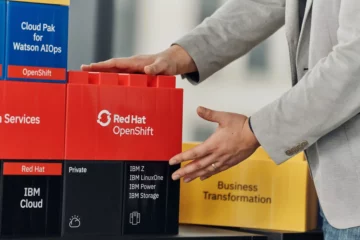<!—->
<!– –>

If you’re in the technology sector (or really, if you’re involved in any business that relies on digital technology at all), you’ve likely heard the buzz around 5G. The latest high-speed cellular network standard is poised to transform wireless connectivity as we know it and usher in a new age of digital transformation.
Like any new technology, however, it’s wise to take a step back and consider the pros and cons before diving in. In this article, we’re going to look at some of the advantages and disadvantages of 5G networks so you can make an informed decision for your business.
What is 5G?
5G (fifth-generation mobile technology) is the new standard for cellular networks. First released by mobile phone companies in 2019, it relies on radio frequencies for data transmission like its predecessors 3G, 4G and 4G LTE networks. However, improvements in latency and bandwidth give 5G certain advantages like lightning-fast download and upload speeds, improved connectivity, and greater reliability.
Why is 5G important?
In the four years since it burst onto the market, 5G has been widely touted as a disruptive technology, capable of transformation on a similar scale to artificial intelligence (AI), the Internet of Things (IoT) and machine learning (ML). As mobile broadband technology expands, the amount of data generated every day is increasing exponentially to the point where 3G and 4G network infrastructures simply can’t handle it. Enter 5G, with its speedy download and upload times and wider bandwidths capable of handling much larger volumes of data.
Advantages of 5G technology
In addition to faster speeds and upload/download times, there are several other important differences between 5G and 3G/4G networks worth noting:
Smaller physical footprint
5G uses smaller transmitters than its predecessors, allowing for them to be placed discretely on buildings, inside trees or in other out-of-the-way places. The cells (or “small cells”) that wireless networks rely on for connectivity are also smaller in 5G networks and require less power to run.
Reduced error rates
5G’s adaptive Modulation and Coding Scheme (MCS)—a schematic for sending data from WiFi devices—is better than the MCS used in 4G and 3G. The result is that the Block Error Rate (BER), which is used for measuring the frequencies of errors in a network, is extremely low. On a 5G network, when the BER increases to a certain level, the transmitter lowers the connection speed until the error rate drops. Essentially, 5G networks trade speed for accuracy in real-time so their BER is always near zero.
Better bandwidth
5G networks can utilize a much broader range of bandwidths than previous networks. By expanding the spectrum of resources it can utilize from sub-3 GHz to 100 GHz and even higher, 5G’s range can include both lower and higher frequencies. This expands the network’s overall capacity and throughput by allowing it to function across a much wider spectrum of bandwidths, increasing the number of devices it can support at a time.
Lower latencies
5G’s low latency (the amount of time it takes data to travel from one point to another on a network) enables the speeds that make activities like downloading a file or interacting with the cloud 10x faster than on a 4G or 3G network. While 4G networks deliver latencies of around 200 milliseconds, 5G networks routinely deliver them as low as a single millisecond.
Disadvantages of 5G
Like any emerging technology, there are as many reasons for caution with 5G as for excitement. Let’s take a look at some of the concerns preventing both consumers and enterprises from wholeheartedly embracing it.
Cybersecurity
While 5G’s algorithms are even more comprehensive than its predecessors, users are still vulnerable to cyberattacks. One area of concern is encryption. While apps on 5G networks are encrypted, the 5G NR standard doesn’t have end-to-end encryption, leaving it open to certain kinds of attacks.
Network slicing
While network slicing is a popular feature of 5G networks, it’s also an area for vigilance. When creating a virtual network for a specific functionality, 5G software is exposed to hackers, malware and other potential breaches. Once a breach has occurred, malware or spyware has the potential to spread throughout a carrier’s infrastructure or networked devices, causing problems across whole enterprises.
Infrastructure
To move services and functionality onto a 5G network, businesses must weigh the cost and time needed to upgrade their equipment so it’s 5G compatible. This can be both time-consuming and expensive. Typically, an enterprise that has relied on 3G or 4G networks for some time has already made a large investment in their equipment. Replacing it and upskilling workers so they can deploy and maintain the new infrastructure presents a significant obstacle.
Gaps in coverage
With the rollout of 5G technology worldwide, many large urban areas now have 5G coverage. However, it’s important to note that 5G still isn’t everywhere and won’t be for a long time. Many remote areas, for example, don’t have a 5G connection or only offer limited coverage. Before companies upgrade to 5G they should take a look at where they plan on using it—especially if they operate in rural areas—to ensure they will have 5G coverage.
Penetration
The high-frequency radio waves that 5G signals travel on are easily blocked by common objects such as buildings and/or trees so ensuring seamless routes for the waves to travel can be a problem. Factories and offices present unique challenges that have caused some businesses to redesign facilities in a way that is more 5G network-friendly.
How does 5G technology work?
5G networks are divided into geographical sections known as cells. Within these cells, wireless devices like smartphones, tablets and computers connect to the internet or phone network by sending radio waves between a base station and an antennae. The underlying technology of a 5G network is the same as that of a 3G or 4G network, but its download speeds are much faster. Some 5G networks’ download speeds can reach as high as 10 gigabits per second (Gbps) if only a few devices are on the network.
As 5G technology reaches more and more customers and the number of applications that support it continues to grow, its popularity with telecommunications companies and Internet Service Providers (ISPs) is also expected to increase. In North America, for example, the most popular ISPs for home internet—Verizon, Google and AT&T—have already adopted it and more than 200 million homes subscribe to it (links resides outside ibm.com).
Three key functionalities set 5G technology apart:
- Cellular standards
- Network slicing
- Private networks
Here’s a closer look at each of those areas, why they are unique to 5G and how they help the technology function.
New cellular standard
The 5G NR (New Radio) standard for cellular networks is the new radio access technology (RAT) specification built specifically for 5G mobile networks. In 2018, the 3rd Generation Partnership Project (3FPP) set out to develop a new global standard for mobile networks to guide the development of devices and applications on 5G networks. Today, cellular networks and manufacturers wishing to power or design 5G devices simply have to follow the 5G NR standard to be in compliance—increasing the ease and likelihood of 5G expansion. According to a recent report by Ericsson (link resides outside ibm.com), 45% of networks worldwide were 5G compatible by the end of 2023, with that number forecasted to rise to 85% by the end of the decade.
Network slicing
On a 5G network, operators can deploy several independent virtual networks on the same infrastructure, powering numerous business applications and enabling users to do even more complex tasks remotely than they can today. For example, enterprises that want to divide up wireless functionality by use case or business model can form a “collection” on a 5G network. Collections give users on that network a more reliable, consistent experience on the mobile device of their choice than would have been possible in previous generations of wireless technology.
Private networks
5G technology allows users to create a private network with enhanced personalization features, such as secure access, improved quality control and added mobility. Because of these features, private 5G is fast becoming popular with global enterprises who want all the power and features of 5G but with added security layers for their business. Private 5G networks let companies manage multiple devices, services and applications in a highly private, secure and efficient environment—more than any public network.
5G use cases
Now that we have a fuller picture of the pros and cons to consider when it comes to 5G and how the new technology works, let’s take a look at how it’s being applied in the real world.
- Autonomous vehicles: Until 5G came along, fully autonomous cars couldn’t operate independently using the 3G and 4G networks available to them because the speed at which they needed to transmit and receive information wasn’t supported. 5G’s lightning-fast capabilities open up the possibility that in the near future, self-driving cars will be as ubiquitous as taxis and delivery trucks on roads everywhere.
- Smart factories: With AI and ML, factories everywhere are already becoming smarter and more efficient. 5G will make even more leaps possible in the future, enabling the automation of more tasks, deployment of cameras and drones to do jobs that previously required a person, and the connection of thousands of smart devices to the internet. It’s dizzying to think of all the potential applications of 5G in the factory setting. This is one area where it is most likely to have a highly disruptive and transformative impact, potentially changing everything from the way fuel usage is measured and optimized, to the design of equipment lifecycles, to how goods are delivered to customers.
- Smart cities: With 5G, urban areas will be able to accomplish everyday tasks like waste and air quality management far more efficiently than ever before. By deploying new Internet of Things (IoT) devices connected to the Internet via 5G networks, cities can manage activities like traffic control, electricity management, waste disposal and even law enforcement with far more control than in the past.
- Virtual reality (VR) and augmented reality (AR): Virtual reality (digital environments that shut out the real world) and augmented reality (digital content that augments the real world) both rely heavily on 5G technology to function and have numerous business applications. For example, mobile phones and smart glasses using virtual and augmented reality technology that runs on 5G networks are already adding digital overlays, live views and other capabilities to stockroom employees, delivery drivers, maintenance workers and more.
- Edge computing: Edge computing refers to a distributed computing framework that brings enterprise applications closer to data sources. Naturally, any technology that relies on the movement of large volumes of data in a wireless environment is going to be enhanced by 5G. In edge computing, 5G specifically brings computation and data storage closer to where data is generated on the network, enabling greater control, lowering costs, and speeding the delivery of insights. According to a recent Gartner whitepaper (link resides outside ibm.com), by 2025, 75% of enterprise data will be processed through edge computing, compared to only 10% today.
IBM and 5G
5G presents big opportunities for app developers, but you need the right platform to take advantage of its lightning-fast upload and download speeds. IBM Cloud Satellite lets you deploy and run apps consistently across on-premises, edge computing and public cloud environments, enabled by secure and auditable communications with IBM Cloud.
Was this article helpful?
YesNo
More from Cloud

February 29, 2024
Think inside the box: Container use cases, examples and applications
5 min read – Container management has come a long way. For decades, managing containerized environments was a relatively simple affair. The modern idea of a computer container originally appeared back in the 1970s, with the concept first being used to help define application code on Unix systems. Modern containerization technology has moved on steadily from those early beginnings, and when companies run containers now, they’re getting a lot more utility for their investment. From small startups to large, established businesses, container frameworks have…

February 26, 2024
IBM Tech Now: February 26, 2024
< 1 min read – Welcome IBM Tech Now, our video web series featuring the latest and greatest news and announcements in the world of technology. Make sure you subscribe to our YouTube channel to be notified every time a new IBM Tech Now video is published. IBM Tech Now: Episode 92 On this episode, we’re covering the following topics: IBM watsonx Orders EDGE3 + watsonx G2 Best of Software Awards Stay plugged in You can check out the IBM Blog Announcements for a full…

February 22, 2024
IBM Cloud delivers enterprise sovereign cloud capabilities
5 min read – As we see enterprises increasingly face geographic requirements around sovereignty, IBM Cloud® is committed to helping clients navigate beyond the complexity so they can drive true transformation with innovative hybrid cloud technologies. We believe this is particularly important with the rise of generative AI. While AI can undoubtedly offer a competitive edge to organizations that effectively leverage its capabilities, we have seen unique concerns from industry to industry and region to region that must be considered—particularly around data. We strongly…
IBM Newsletters
Get our newsletters and topic updates that deliver the latest thought leadership and insights on emerging trends.
Subscribe now
More newsletters
- SEO Powered Content & PR Distribution. Get Amplified Today.
- PlatoData.Network Vertical Generative Ai. Empower Yourself. Access Here.
- PlatoAiStream. Web3 Intelligence. Knowledge Amplified. Access Here.
- PlatoESG. Carbon, CleanTech, Energy, Environment, Solar, Waste Management. Access Here.
- PlatoHealth. Biotech and Clinical Trials Intelligence. Access Here.
- Source: https://www.ibm.com/blog/5g-advantages-and-disadvantages-what-business-leaders-need-to-know/
- :has
- :is
- :where
- $UP
- 00
- 1
- 10
- 100
- 2%
- 200
- 2018
- 2019
- 2023
- 2024
- 2025
- 22
- 26
- 28
- 29
- 30
- 300
- 3rd
- 3rd generation
- 4
- 400
- 41
- 46
- 5
- 5G
- 5g network
- 5G networks
- 6
- 7
- 84
- 9
- a
- Able
- access
- accomplish
- According
- accuracy
- across
- activities
- adaptive
- added
- adding
- addition
- adopted
- ADvantage
- advantages
- Advertising
- age
- AI
- AIR
- algorithms
- All
- Allowing
- allows
- along
- already
- also
- always
- america
- amount
- amp
- an
- analytics
- and
- Announcements
- Another
- any
- apart
- app
- appeared
- Application
- applications
- applied
- apps
- AR
- ARE
- AREA
- areas
- around
- article
- AS
- At
- Attacks
- augmented
- Augmented Reality
- augmented reality (ar)
- augments
- author
- autonomous
- autonomous cars
- available
- awards
- back
- Bandwidth
- base
- BE
- because
- becoming
- been
- before
- being
- believe
- BEST
- Better
- between
- Beyond
- Big
- Block
- blocked
- Blog
- blogs
- Blue
- both
- Box
- breach
- breaches
- Brings
- broadband
- broader
- buildings
- built
- business
- Business Leaders
- business model
- businesses
- but
- button
- by
- came
- cameras
- CAN
- capabilities
- capable
- Capacity
- carbon
- card
- Cards
- cars
- case
- cases
- CAT
- Category
- caused
- causing
- caution
- cell
- Cells
- cellular
- certain
- challenges
- changing
- Channel
- check
- choice
- circles
- CIS
- Cities
- class
- clients
- closer
- Cloud
- code
- Coding
- collections
- color
- COM
- come
- comes
- committed
- Common
- Communications
- Companies
- compared
- compatible
- competitive
- complex
- complexity
- comprehensive
- computation
- computer
- computers
- computing
- concept
- Concern
- Concerns
- Connect
- connected
- connection
- Connectivity
- Cons
- Consider
- consistent
- consistently
- Consumers
- Container
- Containers
- content
- continue
- continues
- control
- copy
- Cost
- Costs
- country
- coverage
- covering
- create
- Creating
- CSS
- custom
- Customers
- data
- data storage
- Date
- day
- decade
- decades
- decision
- Default
- define
- definitions
- deliver
- delivered
- delivers
- delivery
- deploy
- deploying
- deployment
- description
- Design
- develop
- developers
- Development
- device
- Devices
- differences
- digital
- Digital Content
- digital technology
- Digital Transformation
- disposal
- disruptive
- distributed
- distributed computing
- divide
- divided
- diving
- dizzying
- do
- does
- Doesn’t
- Dont
- download
- downloading
- drive
- drivers
- Drones
- Drops
- each
- Early
- earth
- ease
- easily
- Edge
- edge computing
- effectively
- efficient
- efficiently
- electricity
- embracing
- emerging
- Emerging Technology
- employees
- enabled
- enables
- enabling
- encrypted
- encryption
- end
- end-to-end
- end-to-end encryption
- enforcement
- enhanced
- ensure
- ensuring
- Enter
- Enterprise
- enterprises
- Environment
- environments
- episode
- equipment
- Ericsson
- error
- Errors
- essentially
- established
- Ether (ETH)
- Even
- EVER
- Every
- every day
- everyday
- everything
- everywhere
- example
- examples
- Excitement
- Exit
- expanding
- expands
- expansion
- expected
- expensive
- experience
- exponentially
- exposed
- extremely
- Face
- facilities
- factories
- factory
- false
- far
- FAST
- faster
- Feature
- Features
- Featuring
- February
- few
- File
- First
- follow
- following
- fonts
- For
- form
- four
- Framework
- frameworks
- from
- Fuel
- Fuller
- fully
- function
- functionalities
- functionality
- future
- G2
- Gartner
- generated
- generation
- generations
- generative
- Generative AI
- generator
- geographic
- geographical
- get
- getting
- Give
- glasses
- Global
- going
- goods
- greater
- greatest
- Grid
- Grow
- guide
- hackers
- handle
- Handling
- Have
- Heading
- heard
- heavily
- height
- help
- helpful
- helping
- High
- High-Frequency
- higher
- highly
- Home
- Homes
- How
- However
- HTTPS
- Hybrid
- hybrid cloud
- IBM
- IBM Cloud
- ICO
- ICON
- idea
- if
- image
- Impact
- important
- improved
- improvements
- in
- In other
- include
- Increase
- Increases
- increasing
- increasingly
- independent
- independently
- index
- industry
- information
- informed
- Infrastructure
- infrastructures
- innovative
- inside
- insights
- Intelligence
- interacting
- Internet
- into
- investment
- involved
- iot
- IT
- ITS
- Jobs
- jpg
- Key
- kinds
- Know
- known
- large
- larger
- Latency
- latest
- Law
- law enforcement
- layers
- leaders
- Leadership
- leaps
- learning
- leaving
- less
- let
- Lets
- Level
- Leverage
- lifecycles
- lightning-fast
- lights
- like
- likelihood
- likely
- Limited
- LINK
- links
- live
- local
- locale
- Long
- long time
- Look
- Lot
- Low
- lower
- lowering
- lowers
- machine
- made
- maintain
- maintenance
- make
- malware
- manage
- management
- managing
- Manufacturers
- many
- Market
- max-width
- measured
- measuring
- mesh
- million
- millisecond
- milliseconds
- min
- minutes
- ML
- Mobile
- mobile device
- mobile networks
- mobile phone
- Mobile technology
- mobility
- model
- Modern
- more
- more efficient
- most
- Most Popular
- move
- moved
- movement
- moving
- much
- multiple
- must
- naturally
- Navigate
- Navigation
- Near
- Need
- needed
- network
- networks
- New
- news
- Newsletters
- North
- north america
- note
- nothing
- noting
- now
- number
- numerous
- objects
- obstacle
- occurred
- of
- off
- offer
- offices
- on
- once
- ONE
- only
- onto
- open
- operate
- operators
- opportunities
- optimized
- or
- orders
- organizations
- originally
- Other
- our
- out
- outside
- overall
- page
- particularly
- Partnership
- past
- per
- person
- personalization
- phone
- PHP
- physical
- picture
- placed
- Places
- plan
- platform
- plato
- Plato Data Intelligence
- PlatoData
- Plugged
- plugin
- Point
- poised
- policy
- Popular
- popularity
- position
- possibility
- possible
- Post
- potential
- potentially
- power
- Powering
- present
- presents
- preventing
- previous
- previously
- primary
- private
- Problem
- problems
- processed
- project
- PROS
- providers
- public
- Public cloud
- published
- quality
- Radio
- range
- RAT
- Rate
- RE
- reach
- Reaches
- Reading
- real
- real world
- real-time
- Reality
- really
- reasons
- receive
- recent
- redesign
- refers
- region
- relatively
- released
- reliability
- reliable
- relies
- rely
- remote
- remotely
- report
- require
- required
- Requirements
- resides
- Resources
- responsive
- result
- right
- Rise
- roads
- robots
- rollout
- routes
- routinely
- Run
- runs
- Rural
- same
- satellite
- Scale
- scheme
- Screen
- scripts
- seamless
- Second
- sections
- sector
- secure
- security
- see
- seen
- self-driving
- sending
- seo
- Series
- service
- service providers
- Services
- set
- setting
- several
- should
- showing
- shut
- signals
- significant
- similar
- Simple
- simply
- since
- site
- small
- smaller
- smart
- Smart glasses
- smarter
- smartphones
- So
- Software
- some
- Sources
- sovereign
- sovereignty
- Space
- specific
- specifically
- specification
- Spectrum
- speed
- speeds
- speedy
- Sponsored
- spread
- spyware
- squares
- standard
- start
- Startups
- station
- stay
- steadily
- Step
- Still
- storage
- subscribe
- such
- support
- Supported
- sure
- SVG
- Systems
- tablets
- Take
- takes
- tasks
- tech
- Technologies
- Technology
- Technology sector
- telecommunications
- tertiary
- than
- thanks
- that
- The
- The Block
- The Buzz
- The Future
- the world
- their
- Them
- theme
- There.
- These
- they
- Think
- this
- those
- thought
- thought leadership
- thousands
- throughout
- throughput
- thumbnail
- time
- time-consuming
- times
- Title
- to
- today
- top
- topic
- Topics
- touted
- Tower
- trade
- traffic
- Transform
- Transformation
- transformative
- transmission
- transmit
- transmitters
- travel
- Trees
- Trends
- Trucks
- true
- type
- typically
- ubiquitous
- underlying
- undoubtedly
- unique
- unix
- until
- Updates
- upgrade
- upskilling
- urban
- Urban Areas
- URL
- Usage
- use
- use case
- used
- users
- uses
- usher
- using
- utility
- utilize
- Vehicles
- via
- Video
- views
- vigilance
- Virtual
- volumes
- vr
- Vulnerable
- W
- want
- was
- Waste
- waves
- Way..
- we
- web
- weigh
- were
- What
- when
- which
- while
- WHO
- whole
- wholeheartedly
- why
- widely
- wider
- will
- wireless
- WISE
- wishing
- with
- within
- WordPress
- Work
- worker
- workers
- works
- world
- worldwide
- worth
- would
- written
- years
- you
- Your
- youtube
- zephyrnet
- zero












